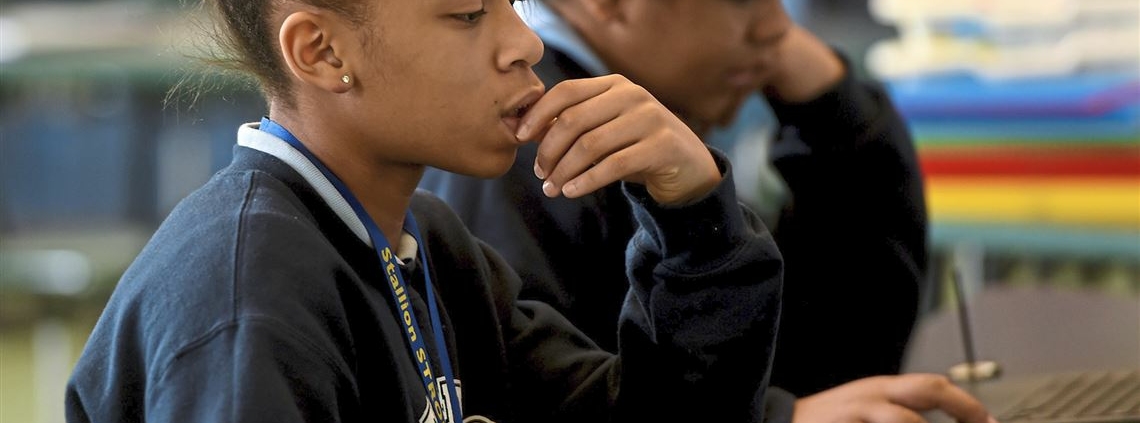Pittsburgh Public looks toward the future with STEAM curriculum
Last fall, before the snow arrived in Pittsburgh, seventh-grade students on the North Side visited the North Pole.
They spoke with scientists there who were studying polar bears and got a glimpse of the gear they were using. The students, warm in their classroom at Pittsburgh Schiller 6-8 in Troy Hill, tweeted their questions to the researchers, who answered them immediately on a live video stream.
“It was very interactive, so the kids loved it,” said Kaitlyn Whitfield, a science teacher at the middle school who arranged the virtual field trip for her classes.
The exercise was set up through Discovery Education, a resource for schools created by the same media company that owns the Discovery Channel. Ms. Whitfield this year has been using the digital program in her seventh- and eighth-grade classes, where her students are now researching the Apollo space missions as part of their unit on lunar phases. She also has used the program’s readings and short video clips for her lessons on the water cycle and electrical circuits.
Pittsburgh Public Schools recently entered a formal partnership with Discovery Education that will enable the district access to its digital curriculum and professional development and training for its educators as the district strives to transform all schools into STEAM-centered learning environments.
STEAM — or science, technology, engineering, arts and math — education has been touted by education experts, business leaders and elected officials across the country as the future of education.
Schools everywhere have been creating maker spaces and mobile science labs, applying for technology grants and developing new computer science and engineering lesson plans, all in an effort to teach students to be creative problem-solvers and to work collaboratively. It’s a quest, experts say, to prepare young people for jobs and careers that haven’t even been created yet.
“This type of learning and what kids are going to have to be able to know and be able to do to have those jobs, we’re not really preparing them based on our current model,” said PPS Chief Academic Officer Minika Jenkins. “We need to make a bigger shift and our classroom environments have not really changed since the Industrial Revolution.”
Initially pitched to the school board as a multi-million dollar purchase and plan to immediately embed the Discovery Education curriculum in all Pittsburgh Public schools, district officials instead decided to phase it in as a pilot program in the district’s six schools that have a STEAM focus. Besides Schiller, a partial STEAM magnet, Langley K-8, Woolslair Pre-K-5, Lincoln Pre-K-5, Brashear High School and Perry High School, will begin using the programs next year.
The district will pay about $657,000 over the next three years for access to the Discovery Education online catalog of resources for students and teachers, as well as the training and support Discovery Education provides to teachers and administrators. In four years, Ms. Jenkins said, the district hopes to roll out the training to all 54 schools and customize a STEAM plan for each building. Even the classroom furniture could look different by then, she said.
“What we’re really doing is changing the culture of [each] school,” she said.
Cassie Quigley, an associate professor of science education at the University of Pittsburgh and a 2019 Pennsylvania STEM ambassador, said many school districts are starting to embrace STEAM education, and supporting teachers with professional development and training is vital to that mission. State standardized tests are also starting to assess “21st-century learning” skills, prompting students to analyze data, construct models, design experiments and communicate the results.
“I think that there are the right sorts of initiatives moving forward,” Ms. Quigley said. “I think schools have a real challenge in their requirements in terms of what they need to do within a certain time frame. I think there are exciting opportunities on the horizon for this sort of work.”
Ms. Quigley, who this month published a book for educators on STEAM practices in the classroom, said Discovery Education allows teachers to be flexible to meet different students’ needs and show students how their subjects are relevant to their daily lives.
According to Discovery Education, schools that have been using its various products across the country have reported positive effects on student performance: improved state test scores in Oak Ridge schools in Tennessee and Miami-Dade schools in Florida; better science scores for students who speak English as a second language in Collier County, Fla.; and better end-of-course exam scores for students in Charlotte-Mecklenburg schools in North Carolina.
Initially under threat of closure, Schiller launched its STEAM program in 2014, said Principal Paula Heinzman. Now, the school has more than 200 students and a waiting list of more than 50 for its sixth-grade classes. For the last two years, it has been a STAR school, ranking among the top schools in Pennsylvania. Seven Schiller eighth-grade students were accepted into Pittsburgh Science and Technology Academy magnet high school for next year, compared to last year’s two, Ms. Heinzman said.
According to the Future Ready PA Index, 47.6 percent of Schiller students scored proficient or advanced on state standardized English language arts tests, 20.1 percent in math and 25 percent in science. All students either met or exceeded state expectations for growth in performance last year.
STEAM teacher Nicole Findon said every student in the school visits her classroom every six days. Each quarter, they study a different subject: computer coding, engineering, robotics and video game design. Ms. Findon, who has been at Schiller for four years, said she writes her own curriculum.
In addition to learning important science and technology skills, she said the goal is for students to take the skills they learn in the STEAM lab and use them to help solve word problems in math class or to analyze passages and documents in language arts.
“(STEAM) is a way of thinking,” Ms. Findon said.
On a recent school day, Schiller students were working in the school’s STEAM lab on the second floor. A sixth-grade student worked on a video game design project, and a group of eighth graders huddled at a desk, connecting computer code that they wrote to a circuit they designed to power small LED lights, motors and motion sensors.
One of the students, Tanzania Livsey, 14, has plans to incorporate the technology into a diorama project, complete with spinning dance floor and light-up disco ball. Xzavier Rodgers, 14, is designing a security system with motion sensors that would send a digital alert to Ms. Findon’s cell phone, activate blinking lights and automatically slide a deadbolt lock into place.
Ms. Heinzman said she was initially skeptical of the virtual field trip to the North Pole in November, because she worried the students wouldn’t participate. But the engagement was “amazing.” She wants Ms. Whitfield to show the school’s other teachers how to use the Discovery Education online resources even sooner than next year.
“We just really need to step our game up because the children want it,” Ms. Heinzman said. “We have to prepare our kids for the jobs we don’t even know about yet. …I feel like this is a resource that helps us achieve that.”
Originally published on March 30, 2019
SOURCE: Pittsburgh Post-Gazette




